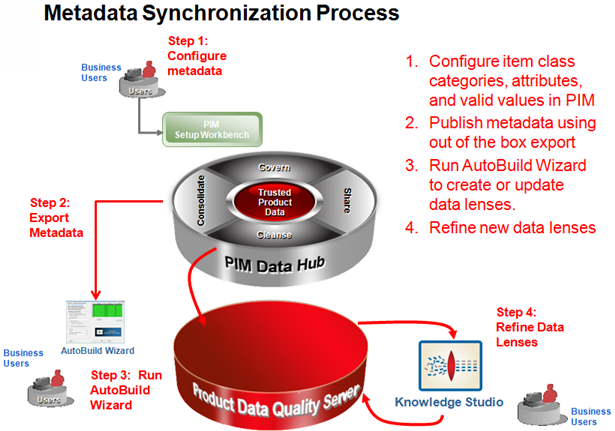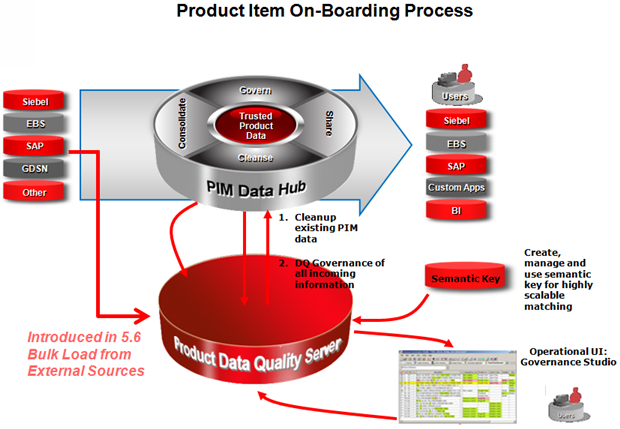| Oracle® Enterprise Data Quality for Product Data R12 PIM Connector User's Guide Release 5.6.2 Part Number E23408-01 |
|
|
View PDF |
| Oracle® Enterprise Data Quality for Product Data R12 PIM Connector User's Guide Release 5.6.2 Part Number E23408-01 |
|
|
View PDF |
Oracle DataLens Server is built on industry-leading DataLens™ Technology to standardize, match, enrich, and correct product data from different sources and systems. The core DataLens Technology uses patented semantic technology designed from the ground up to tackle the extreme variability typical of product data.
Oracle Enterprise Data Quality for Product Data, formerly Oracle Product Data Quality, uses three core DataLens Technology modules: Governance Studio, Knowledge Studio, and Application Studio. The following figure illustrates the process flow of these modules.

The Vision Demo Database, installed with the Oracle E-Business Suite (EBS) on most Oracle R12 Product Information Management (PIM) systems, is a means to provide access to a common set of data. It is available to use as examples and validate the setup and configuration of the Oracle DataLens Server. It uses the ICC name of Capacitors under the Item Class of Passives.
The Enterprise DQ for Product (EDQP) R12 PIM Connector ships with a set of application components to allow you to test and ensure proper system configuration.
The process uses Enterprise DQ for Product (EDQP) AutoBuild to quickly leverage the existing Product Data Hub set of information and the Enterprise DQ for Product Smart Glossaries to create an initial Semantic Model specific to your enterprise content for use within EBS using the R12 PIM Connector. This R12 PIM Connector Semantic Model is known as a "data lens" in EDQP and these terms are in context throughout this document.
The integration of the EDQP solution with the PIM Data Hub (PIMDH) R12 provides an integrated set of capabilities to categorize, standardize, match, govern, validate, correct, and repurpose product data being introduced from any source system(s) or catalog(s). It provides a set of out of the box integration templates in addition to a robust set of interface functions and procedures that can be leveraged to create customized process flows. These process flows consolidate external data from one or more legacy systems into the PIM staging tables, create interfaces to external systems, import entire catalogs or updates to these catalogs, amongst others.
The included templates allow a quick path to performing the following functions:
PIM Metadata Synchronization Templates:
Automatically generate semantic models from the ICC metadata, attributes, and associated valid values.
Provide support for alternate catalog synchronization.
Create Semantic Key Cache to leverage duplicate prevention and cross referencing.
Create PIM Production Batch to cleanse and revalidate existing items in your PIM.
Import external data and load into the PIM staging area by automatically creating a batch.
Run Cleansing and Matching Process to cleanse either external data or PIMDH batches.
The system can be configured to perform any or all of these checks on all batches of data being imported into the system using the Import Workbench process. These configuration steps are fully described in this document. The integration is delivered with a set of preconfigured integration templates that can be personalized to meet your project requirements. The templates allow you to do operations such as the following: validating global attributes or populating Semantic User Defined Attributes (Form, Fit or Function) for an item on-boarding process using the EDQP system.
For most effective metadata synchronization, the PIM ICC structure should be set up as a product hierarchy (for example, Category family, Category group, Category line, or Category.) A product hierarchy contains multiple levels and each level is identified by a set of defining attributes. The levels must be non-overlapping and unique. Each PIM item should correspond to a single ICC. The category-specific semantic attributes must be defined at the leaf-node level while the more general category attributes may be defined at higher ICC levels.
There is a one-to-one relationship between the ICC structure and the data lens generated from the Semantic Model. Since a product hierarchy ICC structure ensures that any given item will have only one Semantic Model, the process of standardizing data is automated, accurate, and reproducible. If a PIM system were to contain more than one ICC for a given category, then multiple Semantic Models and possibly multiple standardization rules could exist for a given item. This can be successfully avoided by upholding the one-to-one relationship between the ICC structure and the Semantic Models, a natural result of using a product hierarchy.

The integration of the EDQ for Product Data solution with the PIM Data Hub R12 system adds an important set of data quality capabilities every time product data is imported using the Import Workbench into PIM. The set of pre-built integration processes allow for various automated data quality checks such as:
Automated Categorization of data into the correct ICC.
Automated assignments to alternate catalogs categories thru ICC and attribute mappings.
Automated extraction, validation and standardization of category specific attributes.
Automated validation and standardization of primary and global attributes.
Automated multiple description generation and standardization from category specific attributes.
Duplicate identification and merge of incoming data.
Duplicate prevention and cross-reference of new items to existing items in the production tables.
Remediation step for items not meeting standards, assisted by AutoSuggest feature.
Exception identification and routing.

To use all of the R12 PIM Connector functions, you must ensure that you have completed the following actions before using the R12 PIM Connector:
Install the EBS server (including the latest patch sets)
Install and configure the R12 PIM Connector 5.6.2.
For installation instructions, see Oracle Enterprise Data Quality for Product Data PIM Connector Implementation Guide.
Install and configure an EDQP 5.6.2 Oracle DataLens Server.� For instructions, see Oracle Enterprise Data Quality for Product Data Oracle DataLens Server Installation Guide.
Install the EDQP 5.6.2 client software.� For installation instructions, see "Installing the Client Software".
Install and configure the EDQP Services for Excel 5.6.2�. For instructions, see Oracle Enterprise Data Quality for Product Data Services for Excel Reference Guide.
Identify EBS user that will be used. Typically, this is plmmgr or pimmgr. The basic outline for creating your own users with the appropriate R12 PIM Connector roles is described in "Creating R12 PIM Connector Users".